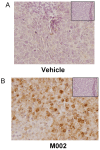Preclinical evaluation of engineered oncolytic herpes simplex virus for the treatment of pediatric solid tumors
- PMID: 24497984
- PMCID: PMC3907427
- DOI: 10.1371/journal.pone.0086843
Preclinical evaluation of engineered oncolytic herpes simplex virus for the treatment of pediatric solid tumors
Abstract
Recently, investigators showed that mice with syngeneic murine gliomas that were treated with a neuroattenuated oncolytic herpes simplex virus-1 (oHSV), M002, had a significant increase in survival. M002 has deletions in both copies of the γ134.5 gene, enabling replication in tumor cells but precluding infection of normal cells. Previous studies have shown antitumor effects of other oHSV against a number of adult tumors including hepatocellular carcinoma and renal cell carcinoma. The purpose of the current study was to investigate the oncolytic potential of M002 against difficult to treat pediatric liver and kidney tumors. We showed that the oHSV, M002, infected, replicated, and decreased cell survival in hepatoblastoma, malignant rhabdoid kidney tumor, and renal sarcoma cell lines. In addition, we showed that in murine xenografts, treatment with M002 significantly increased survival and decreased tumor growth. Finally, these studies showed that the primary entry protein for oHSV, CD111 (nectin-1) was present in human hepatoblastoma and malignant rhabdoid kidney tumor specimens. We concluded that M002 effectively targeted these rare aggressive tumor types and that M002 may have potential for use in children with unresponsive or relapsed pediatric solid tumors.
Conflict of interest statement
Figures








Similar articles
-
Preclinical evaluation of engineered oncolytic herpes simplex virus for the treatment of neuroblastoma.PLoS One. 2013 Oct 10;8(10):e77753. doi: 10.1371/journal.pone.0077753. eCollection 2013. PLoS One. 2013. PMID: 24130898 Free PMC article.
-
Enhanced Sensitivity of Patient-Derived Pediatric High-Grade Brain Tumor Xenografts to Oncolytic HSV-1 Virotherapy Correlates with Nectin-1 Expression.Sci Rep. 2018 Sep 17;8(1):13930. doi: 10.1038/s41598-018-32353-x. Sci Rep. 2018. PMID: 30224769 Free PMC article.
-
Enhanced IL-12 transgene expression improves oncolytic viroimmunotherapy.Front Immunol. 2024 Jun 4;15:1375413. doi: 10.3389/fimmu.2024.1375413. eCollection 2024. Front Immunol. 2024. PMID: 38895115 Free PMC article.
-
Replication and Spread of Oncolytic Herpes Simplex Virus in Solid Tumors.Viruses. 2022 Jan 10;14(1):118. doi: 10.3390/v14010118. Viruses. 2022. PMID: 35062322 Free PMC article. Review.
-
Oncolytic herpes simplex virus and immunotherapy.BMC Immunol. 2018 Dec 18;19(1):40. doi: 10.1186/s12865-018-0281-9. BMC Immunol. 2018. PMID: 30563466 Free PMC article. Review.
Cited by
-
Interleukin-12 Delivery Strategies and Advances in Tumor Immunotherapy.Curr Issues Mol Biol. 2024 Oct 16;46(10):11548-11579. doi: 10.3390/cimb46100686. Curr Issues Mol Biol. 2024. PMID: 39451566 Free PMC article. Review.
-
Oncolytic virotherapy for pediatric malignancies: future prospects.Oncolytic Virother. 2016 Aug 11;5:73-80. doi: 10.2147/OV.S96932. eCollection 2016. Oncolytic Virother. 2016. PMID: 27579298 Free PMC article. Review.
-
Newly Characterized Murine Undifferentiated Sarcoma Models Sensitive to Virotherapy with Oncolytic HSV-1 M002.Mol Ther Oncolytics. 2017 Sep 13;7:27-36. doi: 10.1016/j.omto.2017.09.003. eCollection 2017 Dec 15. Mol Ther Oncolytics. 2017. PMID: 29034313 Free PMC article.
-
Effect of Repeat Dosing of Engineered Oncolytic Herpes Simplex Virus on Preclinical Models of Rhabdomyosarcoma.Transl Oncol. 2016 Oct;9(5):419-430. doi: 10.1016/j.tranon.2016.07.008. Transl Oncol. 2016. PMID: 27751346 Free PMC article.
-
Pediatric cancer gone viral. Part II: potential clinical application of oncolytic herpes simplex virus-1 in children.Mol Ther Oncolytics. 2015;2:15016-. doi: 10.1038/mto.2015.16. Epub 2015 Sep 16. Mol Ther Oncolytics. 2015. PMID: 26436134 Free PMC article.
References
-
- Stocker JT (1994) Hepatoblastoma. Semin Diagn Pathol 11: 136–143. - PubMed
-
- Giacomantonio M, Ein SH, Mancer K, Stephens CA (1984) Thirty years of experience with pediatric primary malignant liver tumors. J Pediatr Surg 19: 523–526. - PubMed
-
- Amar AM, Tomlinson G, Green DM, Breslow NE, de Alarcon PA (2001) Clinical presentation of rhabdoid tumors of the kidney. J Pediatr Hematol Oncol 23: 105–108. - PubMed
-
- Zhuge Y, Cheung MC, Yang R, Perez EA, Koniaris LG, et al. (2010) Pediatric non-Wilms renal tumors: subtypes, survival, and prognostic indicators. J Surg Res 163: 257–263. - PubMed
Publication types
MeSH terms
Substances
Grants and funding
LinkOut - more resources
Full Text Sources
Other Literature Sources
Medical
Miscellaneous

